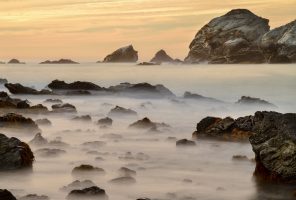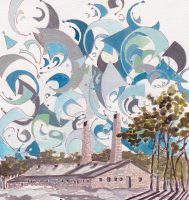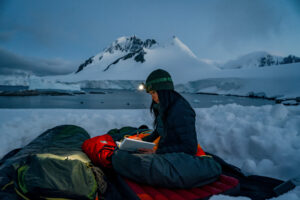Ad Free. Reader Funded.
Your contribution supports our partnership with the author of this piece. On top of their article pay, 50% of all contributions go directly to this journalist.
% of $ Goal
Total number of contributions so far:
0
Total amount raised for journalists
$0
“One thing I really appreciated about working with Hidden Compass is that it’s a space where there is time for nuance and complexity. By donating, that’s what you’re supporting. You’re able to help us as writers, but also as an outlet, continue to tell these kinds of stories.”
- Anna Polonyi, Hidden Compass Journalist
“The reason why I contributed was because the article that I read really resonated with what I was feeling. I felt like the author was in my head... It just moved me and I felt like I needed to do something.”
- Hidden Compass Reader
“Baja’s rock art gives up its secrets in grudging increments and only to those who persevere.”
– Harry Crosby, The Cave Paintings of Baja California
I pull back on the reins and bring my mule, El Caballero, to a halt at the edge of a vertigo-inducing precipice in Baja’s desolate and starkly beautiful Sierra de San Francisco.
As I survey the 3,000-foot-deep gorge into which we are about to descend, I’m filled with apprehension.
Ahead, Loreto Arce, my vaquero guide, maneuvers his mule alongside mine, which has bunched with the burros in the group at the canyon rim and seems to share my doubts about proceeding further. The burros are loaded with camping supplies for our overnight trip to see the cave paintings here that have mystified visitors for centuries.
“Huh,” Loreto yells at his reluctant pack animals. “B’rro. B’rro. Huh.”
The burros conclude they can linger on the canyon edge no longer. They scramble down the steep, serpentine trail, the bells around their necks sending raucous clangs into the empty desert plateau.
I give El Caballero’s reins a shake.
Dutifully, he ambles forward, clambering over wind- and sand-polished rocks and wending through a thicket of cacti before dropping down a trail so steep I’m forced to lean completely back in the saddle to maintain my balance.
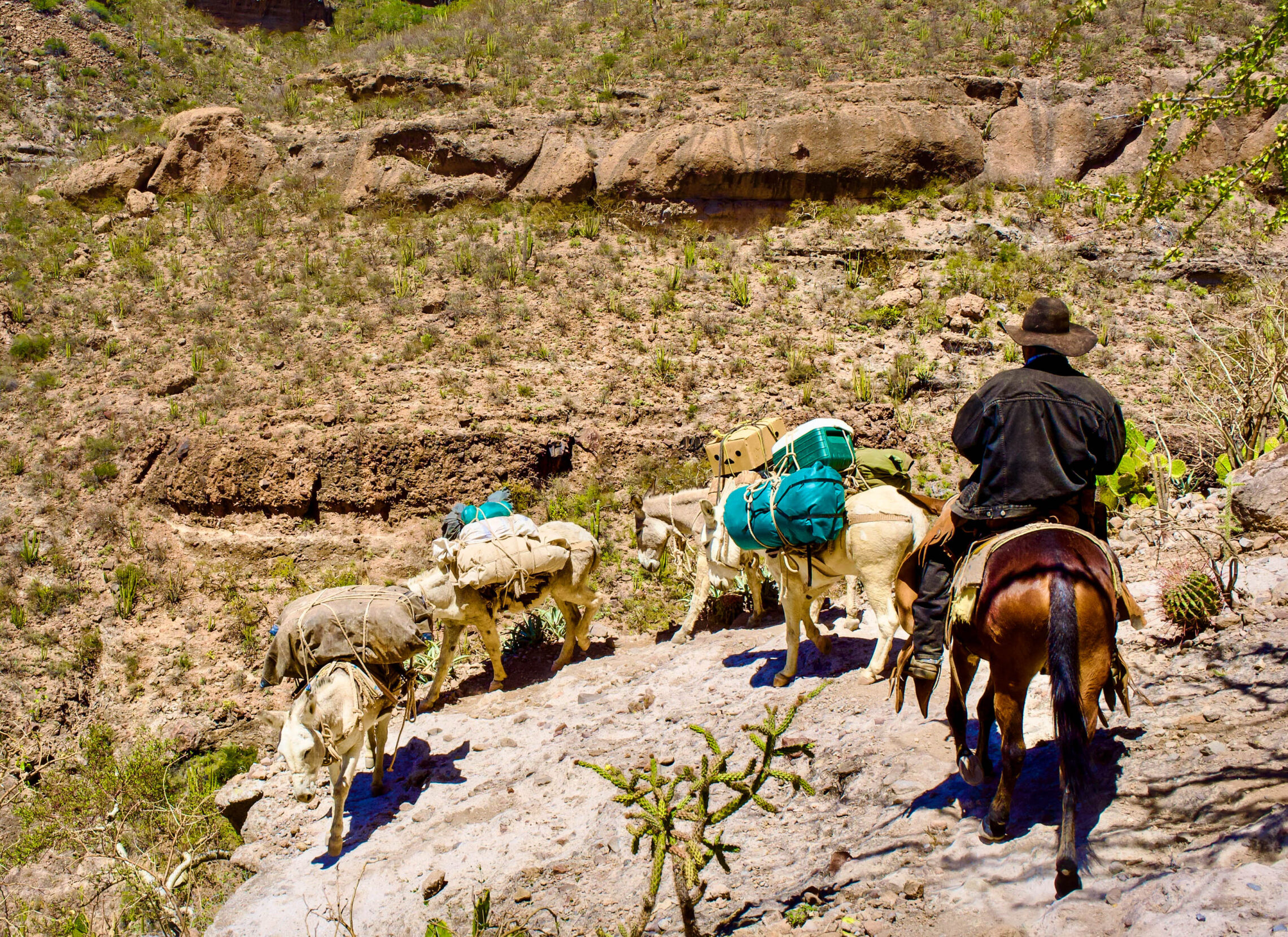
In the rugged realms of Baja California, writer Craig K. Collins follows guide Loreto Arce as he shepherds a team of burros along a cliffside trail. The group is descending into Arroyo Santa Teresa. Photo: Craig K. Collins.
~~
In 1971, Harry Crosby, a former high school science teacher from San Diego, ventured to Sierra de San Francisco during a Baja photo shoot. He’d spent two weeks riding mules from mountain rancho to mountain rancho, photographing and interviewing the people of this remote, mile-high plateau. On his final day before returning to the U.S., his guide — a rancher named Tacho Arce — said he wanted to show Crosby one last thing. Reluctantly, Crosby agreed and soon found himself scaling a rugged trail to view some cave art. Crosby, who’d previously traveled to Europe to see the renowned painted caves in Lascaux, France, and Altamira, Spain, was prepared to be unimpressed.
He was wrong.
“I was astonished and overwhelmed,” Crosby later wrote. “The impact of that grand artistic statement at that moment was bewildering …. The flamboyant painted scene at San Gregorio was alive and eloquent; the artists’ work was an unforgettable message blazed across the ages. Nothing I had encountered before so put me in the presence of a supposedly unknowable people.”
Painted upon the rock-cliff overhang “was a tumultuous procession of human and animal figures at perhaps double their life size. All the beasts seemed to form a herd in movement from right to left; huge red-and-black deer and equally immense red mountain sheep dominated the surge. The successive figures were partially superimposed, creating a powerful sense of crowding, urgency and motion — each animal in mad flight.”
Among the stampede were “strangely static” human figures, “frozen into erect postures with their arms upraised.”
Crosby immediately sensed that the rock art — known here as a rupestre — at San Gregorio was vastly ancient.
“This grand mural seemed entirely out of place. I realized as I stared up at it that I was carried back to paleolithic Europe. The art simply did not resemble anything I knew from the Americas.”
Tacho told Crosby that he was the first outsider to view the cave at San Gregorio, an event Crosby later described as a “happy accident, a once-in-a-lifetime stroke of fortune.”
Further, Tacho said, “there were … many more such works in the area and no one from the outside — Mexican or American — had ever visited any of them.”
~~
There is life and death. Red and black. Hunter and hunted. Man and woman. Old and young. Physical and spiritual. Here and beyond.
It is a fine spring day as we begin our descent into some of the most daunting terrain in North America.
My guide Loreto is from the same Rancho San Gregorio Crosby first visited in 1971. A relative of Tacho’s, Loreto has lived all 44 of his years in that community, which has no vehicle access and is a four-hour mule ride away. Loreto is stout and friendly, speaks no English, and is tolerant of my rusty Spanish.
We are joined during our descent by Loreto’s cousin Juan Ojeda Arce. Juan has lived all 40 of his years in Rancho la Soledad, another roadless community, this one a five-hour mule ride distant.
The sky here is powder blue and nearly always cloudless. A relentless sun beats down upon a land nearly devoid of shade that hasn’t seen rain in months. And in spite of that, a bounteous array of desert flora, uniquely evolved to thrive in this harshest of ecosystems, provides a verdant sheen atop the rust-tinted earth. While the vegetation appears velvety and green from a distance, it is anything but when we are in the midst of it.
I quickly realize everything out here has evolved to reject the presence of humans. There is the cardon cactus and Boojum tree, or cirio, elegant and endemic to Baja, towering to over 30 feet. The trail is lined in places by mesquite, their 2-inch-long thorns a menace to a rider’s shoulders, arms, and face. There is an array of mid-sized cacti, ready to bloody your knees and thighs, going by names such as cholla, barrel, fishhook, and prickly pear. And if that weren’t enough, the ground is flush with hedgehog and creeping-devil cacti — sneaky bastards that seemingly lie in wait like land mines, prepared at any moment to savage your feet and ankles.
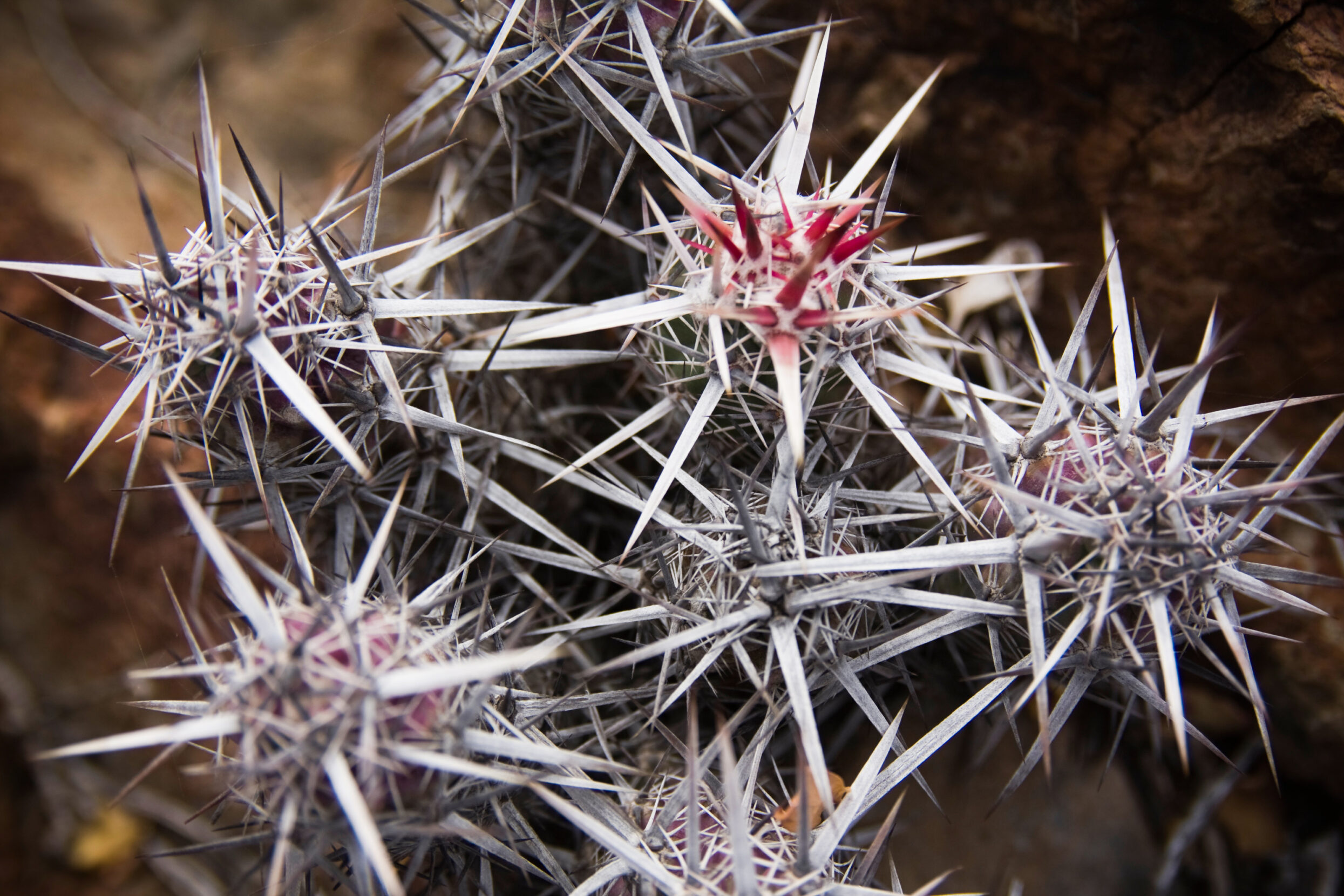
A trek through the Sierra de San Francisco is a thorny endeavor. Photo: Ethan Welty / Aurora Photos.
Then, of course, there are the rocks — slick, weather-worn, ubiquitous. There are no straight, level, soft stretches of trail in this region. Progress is always hard-earned and treacherous.
As for El Caballero, he is nonchalant about it all. Five centuries of breeding, first by Spanish conquistadors, then by Jesuit missionaries, and then by Mexican vaqueros, have made El Caballero finely tuned to this land. He is patient and nimble. His hooves are small and unshod. He ambles steady and sure-footed over a trail that would certainly bring most humans to their knees.
Although the descent into the arroyo is spectacular, we pay little heed to the dramatic vistas, instead focusing on the cuesta, which is a steep, cliffside trail likely first hewn by Spanish Jesuits some three centuries earlier and perhaps used as footpaths by the Indigenous Cochimi for centuries before that. In places, the mules and burros clatter over bare rock, only a foot or two away from sheer drops of 100 feet or more.
After a three-hour journey, we drop down a final series of switchbacks and arrive in a deep arroyo, shaded by towering canyon walls and filled with palms that rustle in a cool, welcome breeze.
The burros and mules file into a fenced campsite that’s part of Rancho Santa Teresa, a collection of palm-thatched roof dwellings inhabited by the Arce Ojeda family.
It’s here we set camp for the night.
~~
We stop, catch our breaths, wipe sweat from our faces, and take swigs of water before gazing up with wonder at the majesty and mystery.
From the time Crosby first viewed the mural at San Gregorio, he was obsessed — so much that he transformed himself into something of an Indiana Jones of ancient rock art for the next three decades. By this day, he has almost certainly visited more rock paintings in Baja than any other person before or since. Crosby, with Techo as his guide, managed to document more than 1,600 sites while traveling more than 1,000 miles on a mule.
The paintings here are vivid panoramas of mostly red and black, the latex-like paint, Crosby surmised and archeologists later confirmed, created from volcanic cinder crushed to a powder, mixed with cactus sap and applied with paint-soaked deerskin pads attached to 20-foot-long pitaya stalks. Because these paints are rock-based, they have weathered well. The images are sharp. The colors pop. Some are so well preserved they seem recent.
The quest to pinpoint the age of the murals has been a long one.
The Jesuits, who first arrived in Baja in 1683 and established the nearby Mission San Ignacio in 1728, were convinced that the paintings were ancient and created by a people who pre-dated the native Cochimi tribe, although they had no way to prove this.
UCLA archeologist Dr. Clement Meighan conducted some of the first scientific studies of the region during the early 1960s. Based on carbon dating of artifacts found at various cave sites, he pegged the creation of the murals at somewhere between 500 and 1,000 years ago.
Crosby, however, never wavered from his initial impression that the true age of the murals spanned several millennia, even though he, like the Jesuits, had no way to prove it.
More recently, a team composed of a geoscientist from Australia, archeologists from Mexico’s National Institute of Anthropology and History (INAH), and Argentina’s National Scientific and Technical Research Council set out to use modern scientific methods and carbon-dating techniques to finally provide a more accurate age range for the Great Murals. Late last year, the team published its paper in “Rock Art Research,” a peer-reviewed scientific journal dedicated to the global study of rock art.
And the results are indeed astonishing.
~~
Dawn comes to Rancho Santa Teresa with a cacophony of crowing roosters, bleating goats, and braying burros.
After a breakfast of eggs and coffee brewed over a roaring campfire, we sojourn with our mules down a boulder-strewn arroyo.
After two miles, we dismount and ascend a cliff-clinging trail that snakes above a deep fissure in the volcanic bedrock.
A half-mile later, we arrive at a long wooden platform anchored to the slope. We stop, catch our breaths, wipe sweat from our faces, and take swigs of water before gazing up with wonder at the majesty and mystery that is Cueva de las Flechas — Cave of the Arrows.
We’re greeted by four human figures, known to archeologists as monos, towering up to 15 feet high. Each is in the common style of the Great Mural region, with arms outstretched, bent 90 degrees at the elbows, hands reaching for the sky. To me, they project an eerie, almost alien sense.
The first two figures are red on the left, black on the right, and the second is transposed over a majestic red mule deer buck. He is a shaman with an elaborate headdress. To his right is another shaman. His headdress is black, but his body is red. At his feet, a red bobcat appears to be nipping at his leg. This shaman, however, has been skewered with eight black arrows. To the right is another red shaman. He, too, has a bobcat nipping at him and he, too, is pierced with arrows.
What this means is indeed a mystery. But portions of the story travel clearly through the millennia. It is a drama of life and death. Perhaps an allegory told by a kind of priest. A tale of warfare. Of man killing man. The Painters’ version of the legend of Achilles, maybe, who was felled by an arrow. We’ll never know the full account of this drama, but the general themes are right there, in red and black, for all who visit to see and contemplate.
The artists’ work was an unforgettable message blazed across the ages.
Directly across the arroyo is a 50-foot-high sheer rock face, beneath which is a rupestre nearly two football fields in length. It is our next destination and features one of the most robust collections of rock art on the planet. It is La Pintada, which hosts a panoramic medley of much of what was important in the Painters’ world and features a menagerie of predator and prey; of what I found to be eerie, looming shamans and strange, gnomish figures.
The art here is spectacular, especially when framed by the blue Baja sky and the majesty of the green-and-rust canyon wall opposite the arroyo. A pair of fawns prance into view on the edge of an overhang. Two black, ominous vultures hover at cliff’s edge. A red-striped bighorn ram and a black mule deer buck are superimposed over a gathering of more than a dozen monos — men, women, and shamans. One of the females is cleverly situated so her belly covers a smooth, round, protruding rock.
“Embarazada.” Pregnant, says Juan.
I stand marveling at the walls. It had taken me 12 hours by car, five hours by mule, and 45 minutes on foot to arrive. But in a single glance, I was transported across millennia.

Large red-and-black human figures wearing elaborate headdresses dominate the mural at Cueva de las Flechas in the Sierra de San Francisco. The region, rich in pictograph and petroglyph sites, was named a UNESCO World Heritage Site in 1993. Photo: Ethan Welty / Aurora Photos.
~~
The study by Australian, Argentine and Mexican scientists has validated Crosby’s steadfast belief about the murals’ antiquity; they’re indeed far older than archeologists like Dr. Meighan first determined.
At San Borjitas, a painted cave in Sierra de Guadalupe, south of La Pintada, researchers took paint samples from a human figure pierced by an arrow. Carbon dating placed the age of the arrow at about 4,100 years. The figure’s chest was up to 4,800 years old. A finger was perhaps more than 6,000 years old, and a leg, 6,500 years old.
Thus, the murals appear to have been carefully maintained for not just centuries, but millennia.
The research team noted that their findings “indicate a long cultural tradition, over almost 5,000 years of touching up and adding new figures and elements to the extraordinary polychrome paintings. These modifications were apparently deliberate … [T]he repetitive refreshing of the images … represents an intentional act for maintaining the cultural significance of those motifs. Whether this was for storytelling and an essential part of oral tradition is unknown, but a purposeful effort was made to preserve the motifs.”
The oldest painting — a red-pigment figure of a woman at a rupestre known as La Palmarita in Sierra de San Francisco — dates to the end of the last Ice Age and the approximate arrival of the first humans to the Baja Peninsula. It’s estimated to be up to a mind-boggling 11,000 years old.

A panorama of larger-than-life male and female human figures known as monos are juxtaposed over images of bighorn sheep, mule deer, and fawns in Cueva La Pintada. The paint was made by grinding colored volcanic rock into a powder and mixing with a viscous concoction of cactus sap. Photo: Craig K. Collins.
~~
The sun dips behind a canyon wall. The temperature drops and a refreshing breeze whispers through the fronds of nearby palms. We turn away from La Pintada and take in the same view that inspired the Painters to designate this as a sacred spot. A network of massive canyons converges here, with Arroyo Santa Teresa melding into Arroyo San Pablo, which in turn twists for miles as it drops toward the Vizcaino Plain. Mexican blue palms trace the canyon floor. The late-afternoon sun burnishes the red-and-gold hues of the west-facing cliffs, and a forest of cardon cacti casts long shadows on the hillside below.
We sit, rest and gaze at the stunning display of nature, just as the Painters must have done 6,000 years ago.
I find myself wondering what it all means. Who were the Painters? What messages were they trying to convey to each other? To their descendants? To us?
Crosby says these questions are largely unknowable. He states in his writings and interviews that it is a mistake to bring modern notions to bear when attempting to discern the meaning of the murals or gain insight into the people who created them.
But I disagree. All art is open to interpretation, and murals from a far distant past are no exception.
I believe modern viewers can learn a great deal from the murals, which tell us much about the Painters — who they were, what they believed, and how they interacted with the physical and spiritual worlds.
These are the product of hunter-gatherers who depended on the world around them for survival and were very much attuned to nature. They relied on deer, bighorn sheep and pronghorns for sustenance, thus giving such animals prominence in the murals. They admired the skills of other hunters — mountain lions, bobcats, hawks and vultures — and gave them ample space in their pantheon of images.
There is much duality in the Painters’ perspective.
There is life and death. Red and black. Hunter and hunted. Man and woman. Old and young. Physical and spiritual. Here and beyond.
“The Painters made these places holy ground,” Crosby wrote, “places where they came to practice the higher human pursuits of magic, ritual and symbolism.”
Ultimately, he’s correct in advising modern viewers to come to the murals with an abundance of humility, expecting mystery rather than answers.
We’ll never know the full account of this drama, but the general themes are right there, in red and black, for all who visit to see and contemplate.
~~
In the early 1990s, thanks largely to the urging and perseverance of Crosby, as well as the diligence of Mexico’s INAH, a team of archeologists and scientists responsible for overseeing the paleolithic cave art in France and Spain visited the Great Murals in Baja. They, like Crosby, were awed and immediately recognized the vivid panoramas as cultural and historic treasures.
In 1993, the Great Mural region was designated a UNESCO World Heritage Site. In conferring this designation, UNESCO cited the region as “one of the most outstanding concentrations of prehistoric art in the world and a dramatic example of the highest manifestations of this human cultural expression.”
~~
We are back at camp, preparing dinner.
Juan stops by and gives the flour tortillas I’d purchased from a supermarket a grim look before pulling from a satchel a cloth bag containing a couple dozen maize tortillas.
“Who made these?” I ask, in Spanish.
“Mi mama,” Juan says, proudly.
He also pulls out a round of goat cheese made at his rancho.
We sit in camp chairs beneath a tree and listen to the campfire crackle. We toast Juan’s tortillas on a grill over an open flame and enjoy a dinner of bean and goat cheese tacos. After the rigors of hiking and mule riding, it is a feast and setting that exceeds anything a Michelin-starred restaurant could offer.
The canyon dims as day gives way to night. The cliffs become shadows, and as the moonless sky recedes to black, a blaze of stars appears overhead. There are no cities of any consequence for over 400 miles in any direction and the celestial display is dazzling.
I learn that Loreto has a wife, three sons and a grandson, all still residing in Rancho San Gregorio. Juan is a late bloomer in his family. He has a wife, a three-year-old daughter, and a three-month-old son.
I ask the guides if they’ve ever considered moving to a city like, say, Ensenada, Tijuana, San Diego or Los Angeles.
They look at me, puzzled.
“No, nunca.” No, never, Loreto replies as Juan nods in agreement.
“I like this life a great deal,” he adds. “It’s very peaceful.”
These aren’t the answers I was expecting.
I stare into the campfire, nodding in contemplation at the flames dancing before me. Soon I realize the absurdity of my question. It’s akin to asking me if I’d ever seriously considered moving to central Baja, where I could herd goats, raise corn, and ride mules.
The ephemeral nature of life, I think, is one of the messages transmitted to us by the Painters. Who’s to say which journey is happier or more noble? A Baja vaquero’s or a San Diego urbanite’s? No matter our material wealth, each of us comes to this life from somewhere in the beyond. We are here for a flash when measured against the millennia when these murals were created or the geologic eons during which these canyons were formed. Death awaits us all, as the Painters remind us with their depictions of black vultures, pumas, shamans, and arrows. And in the end, we return to the beyond from whence we came. Or as the Jesuits were fond of saying: “Ashes to ashes, dust to dust.”
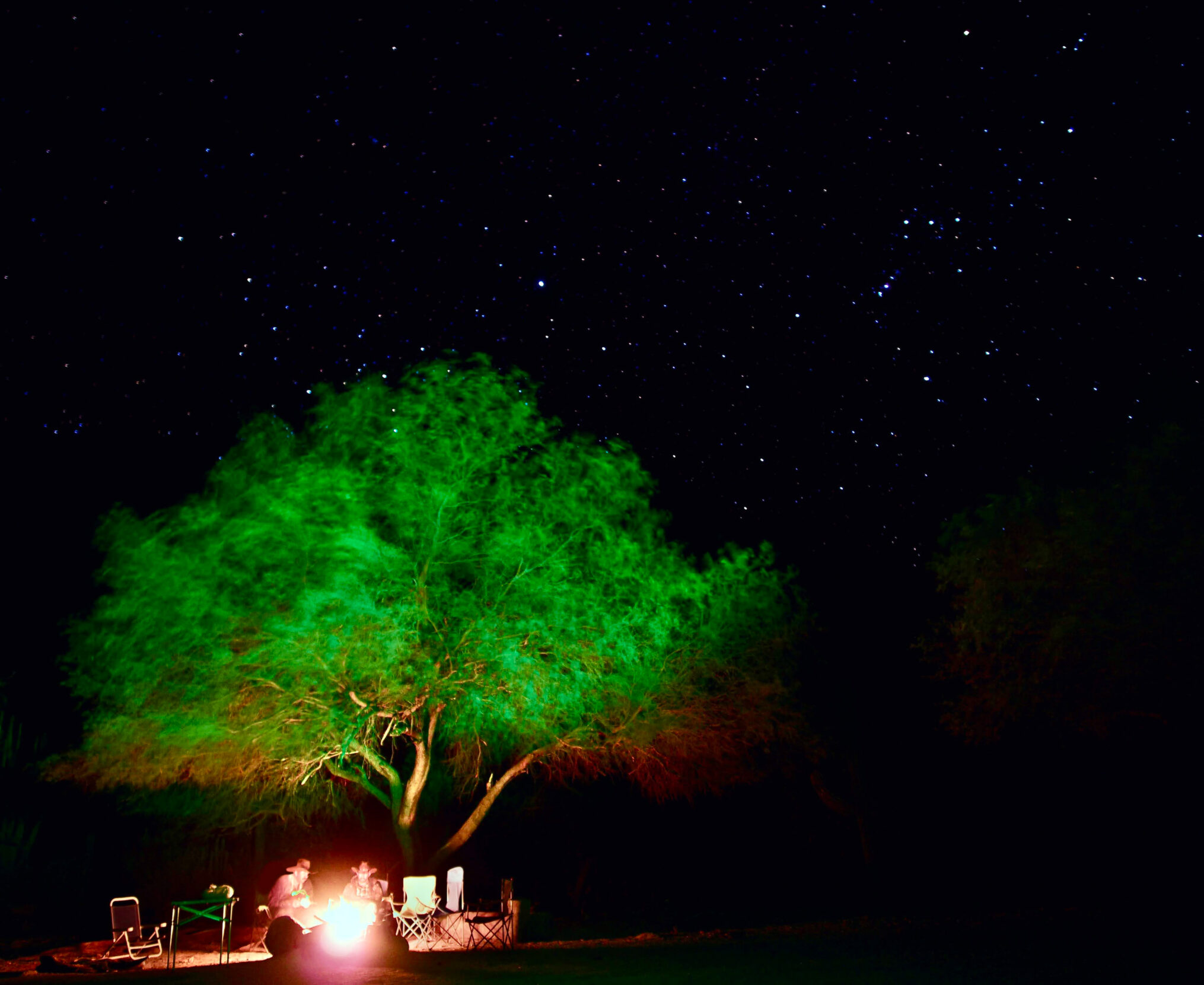
Guides Loreto, left, and Juan Arce, right, talk by the campfire deep into the night at Campamento Santa Teresa. Photo: Craig K. Collins.
~~
“The most common name in the Sierra de San Francisco is Arce,” Fermin Reygadas-Dahl told me on a Zoom call before my trip to Baja. Reygadas-Dahl is an archeologist at the Autonomous University in La Paz and one of the leading experts on the history, geography and people of the Great Mural region. All Arces in this region, he pointed out, can trace their roots to one Juan de Arce, who arrived in Loreto in 1697 with the first of the Jesuit missionaries.
“The Jesuits came to Baja,” said Reygadas-Dahl, “with very high ideals and standards. Not just anyone could be a Jesuit. They had to be educated, have some military training and a profession. The Jesuits brought men who were useful. They were metalsmiths, leatherworkers, stone masons, ranchers, and farmers. And they recruited these men mostly from Andalusia in Southern Spain.”
When the missionaries eventually left, men like the Arces stayed, establishing a network of ranchos throughout the sierra of central Baja. Their descendants and the culture they first brought with them from Andalusia remain largely intact to this day.
Over the millennia that the Great Murals have graced the rupestres in this region, cultures have risen, thrived, and fallen. Today, even the Arces and their ranchero kin face transformation.
“WhatsApp will be the death of the vaquero culture,” jokes Trudi Angell, a Loreto-based ecotourism guide, who, with her daughter Olivia, leads regular mule trips to the Great Murals.
“As recently as the ’70s,” Angell says, “there was no paved highway in Baja. And there wasn’t a road into the mountains until much later. Everyone traveled by mule and burro. It was the only way to get in and out. Recently, the ranchos have gotten TV and radio reception. And about four or five years ago, they got internet connection and now chat with each other incessantly on WhatsApp. Change is always inevitable, even here.”
~~
After a few final jarring bumps, the dirt road ends, and my tires ride smoothly over asphalt once again. As I begin my descent from the plateau, the flat expanse of the Vizcaino desert stretches to the horizon far below. To the east, I can see the shimmer of the Sea of Cortez. To the west, a foggy haze rises out of the Pacific. And to the southeast, I can see a cluster of palms — the oasis of San Ignacio, where one of the oldest and most beautiful of all California peninsula missions still stands. It was there that the Jesuits first heard stories from the Cochimi of ancient painted caves and, intrigued, set out into the sierra with teams of mules, donkeys and burros to investigate.
The Jesuits, by their written accounts, were both awed and perplexed by paintings they knew to be ancient, but appeared to be so vibrant and well preserved.
They, like modern visitors, were left grappling with mystery.
In what is probably the first written reference to the Great Murals, a Baja Jesuit wrote sometime in the 1700s: “It has been impossible to ascertain what these figures, lines and characters mean … The only thing (the Cochimi) say is that they are from their ancestors … One could infer that they are symbols and meaningful signals with which they attempted to leave a memory for posterity of their settlement in that place, or of some wars or other political or natural events.”
Beyond my windshield, I see a hawk sitting fierce and regal atop a cardon cactus, surveying his domain. A dozen or more vultures catch afternoon updrafts, circling black and effortless above the desert floor. I pass a forest of cirios, which in Spanish refers to a long candle. They spindle high above the plain, their tips aflame with the springtime bloom of orange flowers.
A lot has happened here in the 11,000 or so years since La Palmarita was painted — events that make this a land of not only great wonder, but also of tremendous sorrow. At the time of Spanish contact in Baja in the 1530s, it was estimated there were more than 50,000 Indigenous people living on the peninsula, speaking nearly 15 languages and dialects. Immediately after contact, Old World plagues of smallpox, measles and typhus swept through the tribes. The Jesuits, intent on “civilizing” and Christianizing the native cultures, accelerated the spread of disease by resettling tribes in close quarters around central missions. By 1800, the native population here had dwindled to 20,000, resulting in the collapse of the mission system, which depended heavily on the labor and subservience of Indigenous people. By 1900, fewer than 2,000 speakers of native Baja tongues were counted. Today, there may be one such language — although whether it still survives in Baja is uncertain.
In the end, we return to the beyond from whence we came.
To the modern visitor, the Vizcaino may seem like an inhospitable wasteland — one of the most forbidding places on Earth. But to the Painters, this was home. And what a home it was, especially for a society of hunter-gatherers. On the coasts, there was an abundance of sea life that could be harvested — fish, seals, whales. On the desert plains, there were great herds of pronghorn that numbered perhaps in the tens of thousands. In the mountains, there were deer and bighorn sheep. There were also fellow hunters: bobcats, wolves, cougars, hawks and vultures.
Researchers suggest the Painters were attuned to the spiritual and natural world and felt a kinship with both hunter and hunted. They formed communities — tight human bonds. They fought wars. They lived and they died. They had shamans to try to make a deeper sense of it all. And they told their story in dramatic panoramas that have traveled improbably through the millennia like a gift to us all — an enticing mystery for those willing to persevere.
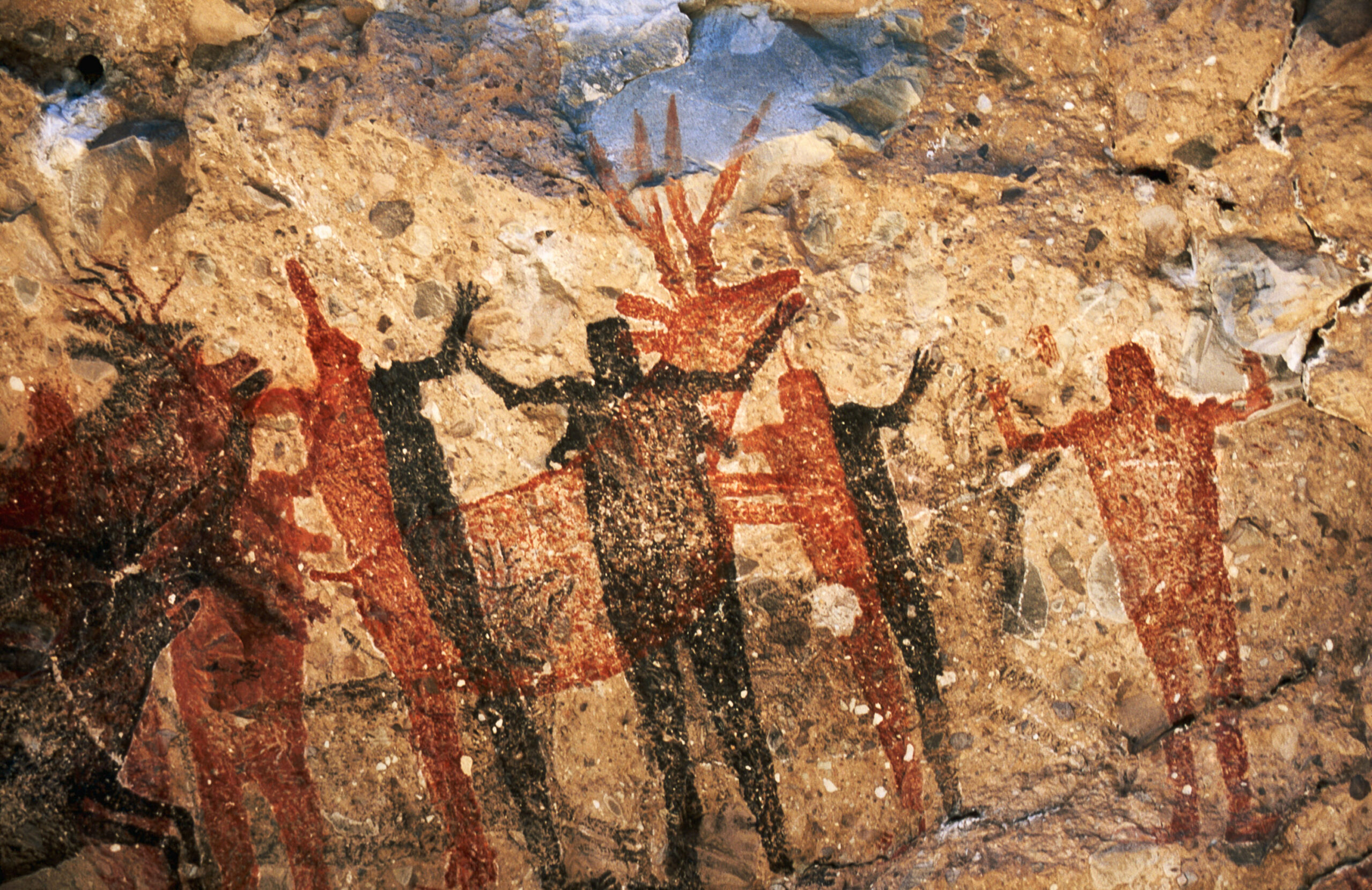
When Harry Crosby viewed the paintings at Cueva la Pintada, very little was known about them. Today, we know more about the age of the art and how they’ve been preserved and tended to over the millennia, but their origins and meaning remain a mystery. Photo: John Elk / Getty Images.
Note: This story has been edited to further clarify the presence of both mules and burros.
Craig K. Collins
Craig K. Collins is a San Diego-based writer and the author of Thunder in the Mountains (Lyons Press, 2014) and Midair (2016); he has a novel due out later this year.
Never miss a story
Subscribe for new issue alerts.
By submitting this form, you consent to receive updates from Hidden Compass regarding new issues and other ongoing promotions such as workshop opportunities. Please refer to our Privacy Policy for more information.

